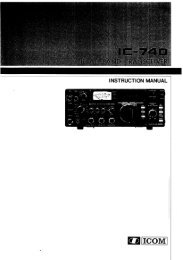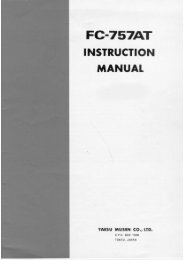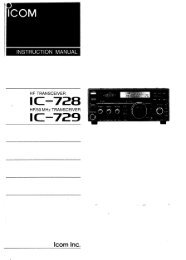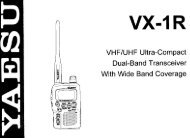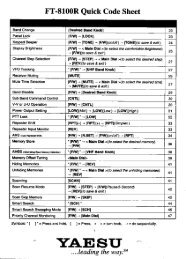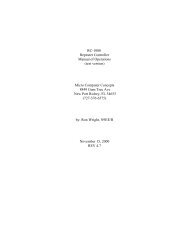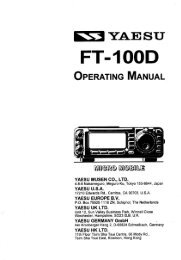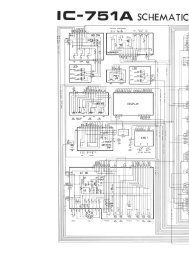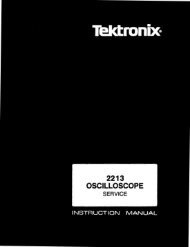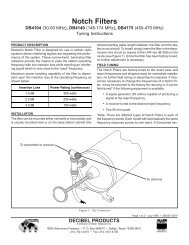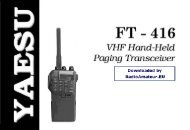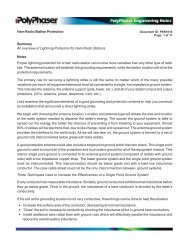VX-7R Technical Supplement - The Repeater Builder's Technical ...
VX-7R Technical Supplement - The Repeater Builder's Technical ...
VX-7R Technical Supplement - The Repeater Builder's Technical ...
Create successful ePaper yourself
Turn your PDF publications into a flip-book with our unique Google optimized e-Paper software.
Circuit Descriptionpassed through a band-pass filter to first mixer Q1013(2SC4915-0). Meanwhile, HF output from the VCO-UNITis amplified by Q1018 and applied through diode T/Rswitch D1046 to mixer Q1013 as the first local signal.<strong>The</strong> 47.25-MHz intermediate frequency product of themixer is delivered to the AF-UNIT.<strong>The</strong> TUNE voltage from the CPU on the CNTL-UNIT isamplified by DC amplifier Q3017 and applied to varactorsD1013 (HVR100) in the variable frequency band-passfilters. By changing the electrostatic capacitance of thevaractors, optimum filter characteristics are provided foreach specific operating frequency.(6) 540 - 999 MHz ReceptionReceived signals between 540 and 999 MHz passthrough the high-pass filter circuit, T/R switch D1004(1SV271) prior to application to RF amplifier Q1002(2SC5277). <strong>The</strong> amplified RF signal is passed through aband-pass filter to first mixer Q1010 (2SC5277). Meanwhile,UHF output from the VCO-UNIT is amplified byQ1016 and applied through diode T/R switch D1045 tomixer Q1010 as the first local signal.<strong>The</strong> 47.25-MHz intermediate frequency product of themixer is delivered to the AF-UNIT.<strong>The</strong> TUNE voltage from the CPU on the CNTL-UNIT isamplified by DC amplifier Q3017 and applied to varactorsD1015 and D1017 (HVC355B) in the variable frequencyband-pass filters. By changing the electrostatic capacitanceof the varactors, optimum filter characteristics areprovided for each specific operating frequency.(7) 47.25-MHz First Intermediate Frequency<strong>The</strong> 47.25-MHz first intermediate frequency from thefirst mixers is delivered from the RF-UNIT to the AF-UNITthrough jacks J1008 and J2001. On the AF-UNIT, the IFfor AM and FM-narrow signals is passed through NAR/WIDE switch D2001 (DAP222) and the 47.25-MHz monolithiccrystal filter (MCF) XF2001 to narrow IF amplifierQ2002 (2SC4915-0) for input to pin 16 of the Narrow IFIC Q2016 (TA31136FN), after amplitude limiting by D2003(DA221).Meanwhile, a portion of the output of 11.7-MHz crystalX1001 on the RF-UNIT is multiplied fourfold by Q2004(2SC4915-0) and Q2012 (2SC4154E) to provide the 46.8-MHz second local signal, applied to the Narrow IF IC.Within the IC, this signal is mixed with the 47.25-MHzfirst intermediate frequency signal to produce the 450 kHzsecond intermediate frequency.This second IF is filtered by ceramic filter CF2002(ALFYM450F=k) and amplified by the limiting amplifierwithin the Narrow IF IC before quadrature detection byceramic discriminator CD2001 (CDBM450C7).Demodulated audio is passed from pin 9 of the NarrowIF IC through the "Mute" analog switch Q2029 (2SJ364)and squelch gate Q2036 (2SJ364) before de-emphasis atQ2028 (DTC144EE).<strong>The</strong> resulting audio is amplified by AF amplifier Q2040(TDA7233D) and fed through the MIC/EAR jack J2002 tointernal speaker SP1001 or an external earphone.(8) Squelch ControlSignal components in the neighborhood of 15 kHz containedin the discriminator output pass through an activeband-pass filter composed of R2059, R2060, R2062, C2076,C2078 and the operational amplifier between pins 7 and8 within Narrow IF IC Q2016. <strong>The</strong>y are then rectified byD2012 and D2013 (MC2850) to obtain a DC voltage correspondingto the level of noise. This voltage is fed to pin49 of CPU Q3035 (HD6472237TF10), which compares theinput voltage with a previously set threshold. When theinput voltage drops below the threshold, normally due tothe presence of a carrier, the CPU turns on squelch gateQ2036 and allows any demodulated audio to pass. At thesame time, Q3001 and/or Q3003 and/or Q3004 goes on,causing the BUSY/TX lamp D3033 (FRGB1312CE-10-TF)to light.Transmitter Signal Flow(1) 145-MHz-Band Transmit/Receive SwitchingClosing PTT switch S2002 on the AF-UNIT pulls the baseof Q3008 (DTA144EE) low, causing the collector to gohigh. This signal is fed to pin 33 (PTT) of CPU Q3035,allowing the CPU to recognize that the PTT switch hasbeen pushed. When the CPU detects closure of the PTTswitch, pin 10 (TX) goes high. This control signal is deliveredto the RF-UNIT, where it switches Q1044 (UMW1)and Q1043 (CPH6102) to produce the TX control signalthat activates Q1046 (2SA1774). At the same time, PLLdivision data is fed to PLL IC Q1019 (MB15A01PFV1)from the CPU, to disable the receiver power saver. Also,it switches Q1048 (KRC654U) to disable the receiver circuits.This causes the "red" mode of BUSY/TX lamp D3033to light.8



